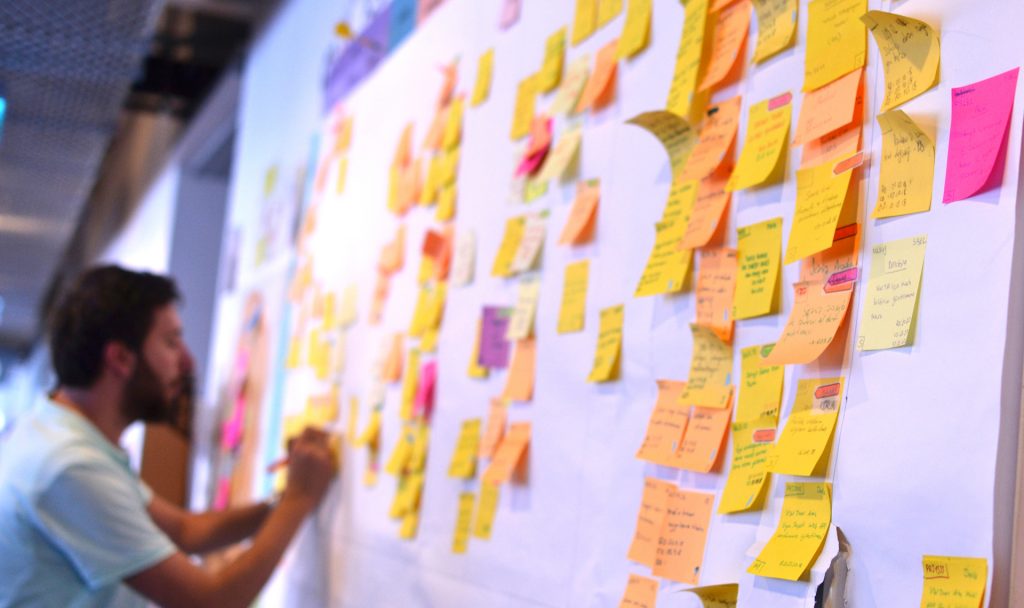What is Scrum

If you’re reading this article and wondering “what is scrum?” then you’ve come to the right place.
The Scrum framework is an agile project management framework that helps teams deliver value incrementally and iteratively. It is based on the empirical process of transparency, inspection, and adaptation, which means that teams are constantly learning and improving as they work. Scrum is the most popular agile framework, and it is used by teams of all sizes and industries to develop products and services.
What is Scrum and Where is it From?
The term “Scrum” is inspired by the rugby scrum, where players work together to push the ball forward.
Scrum is rooted in Agile principles, which emphasise continuous evolution and adaptability. Scrum teams work in short sprints (typically two weeks) to complete a product increment. At the end of a Scrum sprint, the team delivers a working product that can be used by customers or stakeholders. This allows the team to get feedback early and often, and to adjust their plans as needed.
Benefits of Using Scrum for Software Development Teams
- Faster delivery of value: The Scrum team deliver working software to customers after the sprint, which typically lasts two weeks. This means that customers can start using the software and provide feedback early and often. This helps to reduce the risk of delivering a product that does not meet the customer’s needs.
- Higher quality software: By testing their work regularly and by getting feedback from customers and stakeholders. This helps to ensure that the software is free of defects and that it meets the customer’s needs.
- Increased flexibility: Scrum teams can adapt to change quickly and easily because they work in short sprints and constantly get feedback from customers and stakeholders. This makes it easy to add new features or to change the direction of the project as needed.
- Improved team morale: The Scrum team is typically self-organising and collaborative. This means that each team member has a sense of ownership over his or her work, and they are motivated to succeed. This can lead to improved team morale and productivity.
The Disadvantages of Using Scrum
Scrum is a valuable framework for software development teams, but it is important to be aware of the disadvantages of Scrum before implementing it. If your development team is not disciplined or if your project is complex, then Scrum may not be the best fit for you.
- Lack of long-term planning: The Scrum framework is focused on short-term sprints, which can make it difficult to plan for the long term. This can be a problem for projects that require a lot of upfront planning, such as infrastructure projects. Scrum alliances can become too reliant on sprints, which can lead to a “sprint-to-sprint” mentality. This can make it difficult to focus on long-term goals and objectives.
- Difficulty managing complexity: Scrum can be difficult to use for complex projects. This is because a Scrum team is typically small and self-organising, which can make it difficult to coordinate and manage complex tasks.
- Potential for scope creep: Scrum teams are constantly delivering working software to customers, which can lead to scope creep. This is when the scope of the project continues to grow as the team learns more about the customer’s needs. Scope creep can delay the project and increase costs.
If you are considering using the Scrum framework, it is important to weigh the pros and cons carefully to determine if it is the right fit for your team and project. You may also want to consider using a hybrid approach that combines Scrum with other project management frameworks, such as waterfall.
Core Concepts of Scrum Framework
The area where Scrum really shines is making processes coherent and clear for everyone on the team. This allows the team members to get feedback early and often, and to adjust their plans as needed.
Scrum Sprints
Sprints are defined time periods (typically two weeks) where the Scrum team collaborates to complete a product increment. Sprints start with a sprint planning meeting where the team members select the amount of work they will complete during the sprint.
The team then works together to complete the sprint goal and produce a product increment.
At the end of the sprint, the team members deliver the product increment to the customer or stakeholders, and the project manager holds a sprint review meeting to discuss the results.
Empirical Process
Scrum operates empirically, meaning it is based on evidence rather than assumptions. This means that the scrum development team is constantly inspecting and adapting their work based on feedback.
Using sprint reviews and retrospectives to get feedback from customers and stakeholders, the team members then identify key areas where they can improve.
Key Roles in the Scrum Team
Scrum teams are typically made up of three key roles:
- Product Owner: Responsible for driving the product towards its vision and maintaining a constant pulse on the market and customers. They maintain and prioritise the product backlog.
- Scrum Master: Leads the sprint planning meeting and ensures that the team adheres to Scrum principles.
- Scrum Team: Collaborates during the sprint to achieve the sprint goal and produce a product increment.
How to be an Effective Product Owner
The Product Owner should be a visionary with a clear vision for the product and how it will meet the customer’s needs. They should be able to communicate this vision to the team and stakeholders clearly and concisely.
This role is responsible for maintaining and prioritising the product backlog. This means that they need to be able to identify the most essential features and requirements and prioritise them accordingly.
Product development requirements are likely to shift over time, so the Product Owner needs to be responsive to changes and update the product backlog as well.
How to be a Better Scrum Master
The Scrum Master is not the team’s boss. Instead, their role is to help the team remove impediments and to ensure that they are following Scrum principles. Think of being a coach and a mentor.
Helping the team to learn and grow by providing coaching, feedback, and promoting a healthy environment is paramount to being a better Scrum Master. This could involve teaching them new skills, helping them to resolve conflicts, or simply providing support and encouragement.
Lastly, the Scrum Master must protect the team from distractions. The Scrum Master should help the team to stay focused on their sprint goal and shield them from external interruptions or help them to manage their workload effectively.

How to be an Effective Scrum Team
Collaboration is number 1 when it comes to being effective in the scrum development team itself. Scrum teams work best when they are communicative, receptive, and supportive of each other. This means communicating regularly, sharing ideas, and helping each other to succeed.
Remember to be committed to Scrum principles, because these are the founding blocks of the Scrum project and what makes Scrum effective. This helps to ensure that the team is working effectively and that they are delivering value to the entire project.
Three Pillars of Scrum
Three main pillars hold up the Scrum philosophy:
Transparency
Scrum teams are transparent in their work, which means that all information is visible to everyone on the team. This includes the product backlog, the sprint backlog, and the Scrum board. Transparency helps to ensure that everyone on the team is aligned and that the team is working towards the same goal.
Inspection
Scrum teams inspect their work regularly to identify areas where they can improve. This is done through sprint reviews, retrospectives, and daily standups.
Sprint reviews and retrospectives get feedback from customers and stakeholders and identify areas where the team can improve their product and process. Daily standups keep the team members aligned and identify any roadblocks that must be addressed.
Adaptation
Adaptability means that the Scrum team is willing to change its plans based on feedback. This is because the Scrum team understands that the requirements for their product are likely to change over time. They use reviews and retrospectives to identify areas where they need to adapt their plans, and they then make those changes in the next sprint.
Scrum vs. Traditional Project Management
Scrum and traditional project management are two different approaches to managing projects. Here are some of the key differences between Scrum and traditional project management:
- Approach: Scrum teams deliver working products in short sprints, while traditional project teams typically deliver a finished, final product at the end of a long project.
- Collaboration: Scrum emphasises regular collaboration between the team members and with the customer. Traditional project management, on the other hand, has a more hierarchical structure with a focus on command and control.
- Adaptability: Scrum teams are adaptable and can easily change their plans based on feedback. Traditional project teams are typically less adaptable and may have difficulty changing their plans once they are underway.
- Feedback: Scrum teams get feedback from the customer early and often. Traditional project teams typically get feedback from the customer at the end of the project.
Scrum emphasises on short feedback loops. Traditional project management, on the other hand, often follows a linear approach with a focus on planning and execution.
Embrace Scrum: The Agile Framework for Project Excellence
Scrum, inspired by the dynamics of a rugby scrum, stands as a beacon in the agile project management world. It’s a framework that champions transparency, inspection, and adaptation, allowing teams to deliver value incrementally and iteratively. With roots deeply embedded in Agile principles, Scrum focuses on short sprints leading to tangible product increments, ensuring continuous feedback and adaptability. If you’re keen to delve into this transformative approach and lead projects with agility, our scrum master training course is tailored for you. Equip yourself with the nuances of Scrum and steer your projects to success.
Scrum Artifacts
Scrum artifacts are the physical or digital representations of work that a Scrum team produces. They are used to track progress, communicate with stakeholders, and ensure that the team is aligned and working towards a common goal.
There are three Scrum artifacts:
- Product Backlog: The product backlog is a prioritised list of all the features and functionality that need to be added to the product. It is owned by the Product Owner and is constantly evolving as the team learns more about the customer and the market.
Make sure the product backlog is clear, concise, and prioritised. The product backlog should be a living document that is constantly evolving.
- Sprint Backlog: The sprint backlog is a list of all the work that the team commits to completing during a sprint. It is created at the beginning of the sprint and is updated throughout the sprint as the team learns and adapts.
Use the sprint backlog to track progress and communicate with stakeholders. The sprint backlog should be updated regularly to reflect the team’s progress. This helps the team both to keep stakeholders informed and to identify any potential roadblocks early on.
- Product Increment: The product increment is a working version of the product that the team delivers at the end of each sprint. It is used to get feedback from customers and stakeholders and to ensure that the team is on the right track.
The product increment is a valuable tool for getting feedback from customers and stakeholders. This feedback can be used to improve the product and to ensure that the work done by the team is on the right track.
The Scrum artifacts are all interconnected and work together to support the Scrum framework.
Scrum Ceremonies
Scrum teams hold a number of ceremonies throughout the sprint. These ceremonies help to ensure that the team is aligned and on track, and that they are delivering value to the customer.
- Organise the Backlog: The product owner is responsible for maintaining and prioritising the product backlog. This includes backlog grooming, which is the process of reviewing and refining the backlog to ensure that it is up-to-date and that the most important items are being worked on first.
- Sprint Planning: At the beginning of each sprint, the team members hold a sprint planning meeting. During this meeting, the team selects the user stories that they will work on during the sprint and commits to a sprint goal.
- Daily Scrum or Standup: The daily scrum is a brief daily meeting where the team discusses their progress towards the sprint goal and plans for the next 24 hours.
- Sprint Review: At the end of each sprint, the team holds a sprint review meeting. During this meeting, the team showcases the completed backlog items to the product owner and other stakeholders and gets feedback.
- Sprint Retrospective: After the sprint review meeting, the team holds a sprint retrospective meeting. During this meeting, the team reflects on the sprint to identify what worked well and areas for improvement.
Conclusion
All in all, Scrum is a lightweight, agile framework that helps teams deliver value incrementally and iteratively. It is based on the empirical process of transparency, inspection, and adaptation, which means that teams are constantly learning and improving as they work.
The Scrum framework is a valuable methodology in today’s dynamic project environments because of its adaptability and emphasis on collaboration. Scrum teams can respond to change quickly and effectively, and they can deliver value to the customer early and often.
Organizations can benefit significantly from understanding and implementing Scrum principles. The Scrum framework can help organisations to improve their communication and collaboration, increase their visibility and accountability, reduce their risk of failure, and increase their customer satisfaction.





